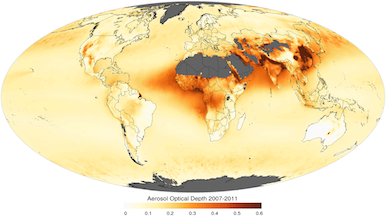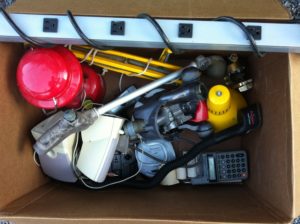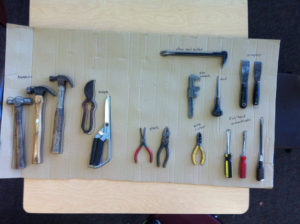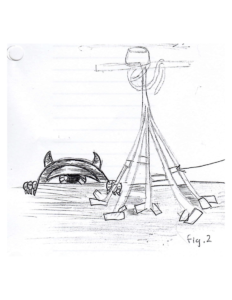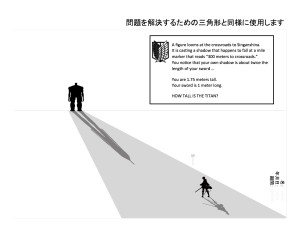Farm Hack at Chimera Arts
Run by Evan, director of Farmers Guild and Dana Woodman, Laser Cutter Instructor and Chimera Director
I sat with at a table with 2 guys who build custom small scale water reclamation systems at the residential level, an Environmental Studies graduate who is starting a podcast on GMOs, and Barbara, who works with a B-corp trying to re-use materials to make bags and potentially clothing using local manufacturing.
There were about 25 people in attendance. I noticed that only 6 were women. I’m curious if this is representative of a typical maker turnout.
The water reclaimers had recently talked with a guy who is designing very expensive green houses that use air to regulate pests using special filters and high power fans without any pesticides.
Ethan’s intro talk: the mission of the farmers guild is to support smaller farmers. This event is to support appropriate equipment for the smaller scale. An example of inappropriate mechanization was a tomato picker machine that only large scale farmers could afford and implement– this machine caused 80% of tomato farmers to go out of business as only large conglomerates were able to afford the machine, lowering their costs and allowing them to out-compete small farmers and then subsume their lands. Small farmers have ingenuity and hard work instead of money. They represent the need for the under $100,000 equipment market.
We did a full room intro. Lots of contractors/builders. Some database programming/ small scale electronics / lots of farmers – small scale, 2 acres or there abouts / Annie – school garden network director / Some ex-engineers
Entries will be judged on cool-factor / practicality (affordability – no budget provided) / usefulness (including replicability)
This make culminates in a competition at the Farmer Olympics (9/17).
White board proposal presentation:
Proposal 1-
In the 1940s Allis Chalmers introduced an awesome little tractor, but it had a weak gasoline engine. There is now a movement to retrofit those old tractors with electric motors.
Some kits and retrofits were done. Farmer has a retrofit. Flaw is that the speed control is not fine tuned enough and is actually pretty unsafe. Looks like a volume control that can be accidentally bumped. Need for a better control unit.
Response – local golf cart control guy who might be able to help
Proposal 2-
Bee keeper – monitoring system for bee hives / temperature / moisture / vibration / app to keep you updated and monitor and record health of hive
Response – look into weather station retrofit
Proposal 3-
Echo farm – sandblasting weeds – actually using abrasive plant material instead of sand – tractor hauled
What about a handheld version?
Proposal 4-
Portable silo trailer – move feed silo to new pastures
Needs to move 2 tons of barley at a time. Let it sprout for 72 hours and then deliver to hogs.
Would move over flat pasture, not needed for winter.
Proposal 5-
Bicycle Harvest Wagon – dual bicycle with adjustable width wheels and platforms between and on sides and behind to hold cargo
Proposal 6-
Person powered Bee Hive Crane for moving hives
Proposal 7-
Hand pollination for corn – need to protect corn silks from windblown pollen when protective cover is removed for hand pollination
Proposal 8-
Hand cranked chipper – small scale human-powered chipper
Proposal 9-
Compost spreader
Proposal 10-
Not actually a proposal, really a tirade on local water rights. Water is starting to be metered even on private wells
Twin Tunnels project to divert the San Juaquin River
Proposal 11-
A water meter that doesn’t impede flow on low pressure lines like drip irrigation.
Proposal 12-
Non-chemical weed control
Most small scale vineyards use vineyard management companies that spray roundup because it’s cheap and easy.
Response – robotic gardener on kickstarter
Response – Every plant has it’s own infrared signature, perhaps use infrared spectrum to analyze individual plant spectrum to differentiate weeds from crops
A lot of excitement around this idea if it’s not too pie-in-the-sky.
Proposal 13-
Fly catcher for cows to pass through to reduce and reclaim flies as protein for chickens
After the proposals there was a Maker Group Organization phase of the meeting:
A group organized around beehive monitor right away:
Make it a kit
Look at existing solutions – ways of using the existing solutions to do what they want
What are the metrics for the group to decide how to meet requirements?
There are a lot of expensive current solutions. This is where I end up a lot of time with maker projects – the solution already exists which steals my thunder a bit.
Annie would love to use it to involve students with the life of bees by analyzing hive health and activity in real time from any computer.
Kit can standardize implementation
Critical mass developed around this group with more and more people gathering around the table. Some just watching, but most offering ideas.
Conversation-
I spoke with Barbara who works with a B-corp trying to re-use materials to make bags and potentially clothing with local manufacture. She commented on how great it was that everyone was confident in presenting their ideas and how this safe supportive space created an environment where that was possible. She then went to track down the pig farmer who uses large bags of barley for the portable silo to see if the bags could have a re-use.
General Info I picked up at the event-
Thursday Night – Sebastopol Makers meetings – group on facebook
Facebook has been the most successful networking tool for Farmer’s Guild.
Teams developed around: Speed controller, Bee hive monitor, Bicycle harvest wagon, Hand crank chipper
Events like this emphasize the importance of ingenuity, and maker thinking routines, regardless of what career choices we make.

